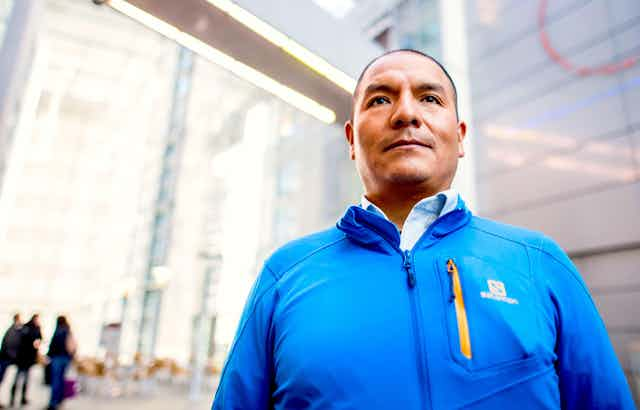On a crisp, sunny day high in the Peruvian Andes, two German judges gaze across a mountain lake to the towering white glaciers in the distance. Dark spots are visible on the pristine ice and, in quiet moments, the cold wind carries the sounds of creaking and cracking.
The judges, from the German city of Hamm, have flown more than 6,500 miles to witness the melting glaciers for themselves. It is May 2022 and their visit has taken more than three years to organise – and some intensive diplomatic negotiations between Peru and Germany. Also here, more than 4,500 metres above sea level, are five German and Austrian scientific experts flying drones to assess whether Lake Palcacocha poses a significant risk of flooding to the thousands of people in the valley below.
A throng of local Peruvian officials have tagged along too, to share their concerns about glacier hazards with the judges. Around two-dozen international journalists and four documentary film teams are in the area to cover the event. But the judges have requested they stay away from the lake so the court can do its work.

The deep-blue water glistens ominously in the sunshine. The lake is fed by the region’s accelerating glacial melt, powered by warming temperatures that were long ago shown to be the result of human climate emissions.
Lake Palcacocha is the subject of an unprecedented climate justice lawsuit. On one side, a German energy giant that is said to be responsible for 0.47% of the world’s industrial greenhouse gas emissions. On the other, a Quechua-speaking farmer who had never travelled outside Peru until he joined this groundbreaking legal challenge.
The unlikely plaintiff
The Cordillera Blanca mountain range in the northern Peruvian Andes is a region shaped by disaster. In 1941, Lake Palcacocha’s banks broke, probably due to an avalanche, devastating the city of Huaraz downstream and killing around 2,000 people.
The region’s most devastating disaster occurred three decades later in 1970, when an earthquake caused another massive avalanche that destroyed the town of Yungay and nearby villages, burying 30,000 people (although many of the town’s children survived because they were attending a nearby circus show). The disaster left a deep impact on the area’s social and cultural fabric. Yungay was permanently relocated and authorities stepped up their efforts to monitor glacial hazards.
As well as being a farmer, Saúl Luciano Lliuya works here as a mountain guide, leading tourists up the icy peaks year after year. Now in his early 40s, he came of age at a time of unprecedented environmental change in his homeland. Avalanches and glacial floods happen more and more often, and he has lost a number of colleagues and friends. Flood modelling studies show that Luciano Lliuya’s family home is in the danger zone if another large avalanche was to fall into Lake Palcacocha, causing its banks to burst.
As in many parts of the world, climate change has intensified existing vulnerabilities in the rural Andes while creating new dimensions of risk. Luciano Lliuya comes from an Indigenous population subjugated by Spanish colonisers that still faces marginalisation today. He grew up speaking Quechua at home and faced discrimination at school in Huaraz. Teachers only used Spanish and beat children for speaking their Indigenous language.
This article is part of Conversation Insights
The Insights team generates long-form journalism derived from interdisciplinary research. The team is working with academics from different backgrounds who have been engaged in projects aimed at tackling societal and scientific challenges.
In recent decades, an upsurge in mountain climbing tourism has created new opportunities for villagers such as Luciano Lliuya, who have traversed high altitudes since an early age. To them, mountains are more than just boulders and ice. “A mountain is a geological formation,” he says, “but another perspective is that the mountains nurture us. They are powerful beings of some sort … For me, the mountain is someone who gives you everything.”
Many of the local people make tribute payments to these mountains, hoping to avoid their wrath and guarantee plentiful harvests. Up at Lake Palcacocha, the villagers who oversee an early-warning flooding system installed by the Ancash region’s government also present ritual offerings to the mountains every month. They say that when they missed one in 2017, an avalanche crashed into the lake causing waves of several metres – but that time, the old safety dams held steady.
Luciano Lliuya too feels a deep responsibility for the mountains that are suffering as they lose their white covers. Before summiting a peak on a climbing tour, he pays respect by laying coca leaves on the glacial ice. If he fails to show respect, he fears the mountain will show its anger.
Almost ten years ago, Luciano Lliuya was introduced via his father to a group of climate activists from the environmental NGO Germanwatch. They discussed the chance to ask one of the world’s biggest greenhouse gas emitters, German energy giant RWE, to make a tribute payment to these mountains too.
If the case succeeds, it could set a global precedent to hold major polluters responsible for the effects of climate change, even on the other side of the world. Already, it has had a significant impact. After the case was declared admissible by the German judges in November 2017 – meaning that Luciano Lliuya had won a key legal argument, if not yet the scientific ones – RWE’s stock value took a hit. This reflects a broader trend: international companies and their investors are waking up to the financial risks posed by climate litigation.
Taking on a German energy giant
Meeting Luciano Lliuya in his tiny village of Llupa, you’d hardly think he’d become something of a climate justice celebrity. The case has taken him to German courts and international UN summits. Having once been nervous about speaking at his local village assemblies, he has now addressed thousands of people at major climate marches and given countless interviews to the world’s press.
At home, his quiet life is periodically disturbed by visiting film teams. He says he doesn’t care much for stardom, but appreciates the interest in his legal case:
I want people to know what we’re facing here in Peru. The people in wealthy countries like Germany should understand how climate change is making our lives more dangerous. Perhaps that will motivate them to stop polluting so much.
I first visited his two-storey family home in December 2014, when I was asked to interpret for three representatives from Germanwatch (I’ve since worked with Luciano Lliuya as a legal strategist, scientific adviser and academic researcher). We were treated to a special meal of guinea pig and potatoes with red chilli sauce. Half-way through, he smiled and glanced around the table at his fellow diners including his father, Julio. Then he told us all quietly: “I’ll do it. I’ll do the claim.”

That moment marked a transformation of Luciano Lliuya’s life – and mine. In the run-up to the 2014 UN Climate Summit (COP20) in Peru’s capital, Lima, Germanwatch employees had been taking an interest in the Cordillera Blanca mountain range – a region of particular concern for its vulnerability to climate change. Having recently lived in Peru, I joined the team as they looked for local people in the Andes to help voice this concern.
A Peruvian friend who was working with local farmers in the region suggested Julio Luciano Lliuya, who had recently told him how badly climate change was affecting their community’s livelihood. Following two weeks of intense UN negotiations at the COP20 summit, I embarked on an eight-hour bus ride to Huaraz with three Germanwatch representatives.
Father and son met us in the city with their rickety old Toyota van. Navigating uneven dirt-track roads, they took us on a tour of the mountains and told us about their climate-related concerns: in the short term, glacial retreat causing disastrous avalanches and floods; in the longer term, water scarcity threatening their very way of being.
Keen to show us the glaciers up close, Julio’s only son Saúl took us on a six-hour trek up to Lake Palcacocha. The hike was so strenuous that two of my colleagues had to turn around halfway, struggling with altitude sickness. Whatever breath I had left was taken away when I first glimpsed the lake, with those shiny white glaciers framing its deep blue water.
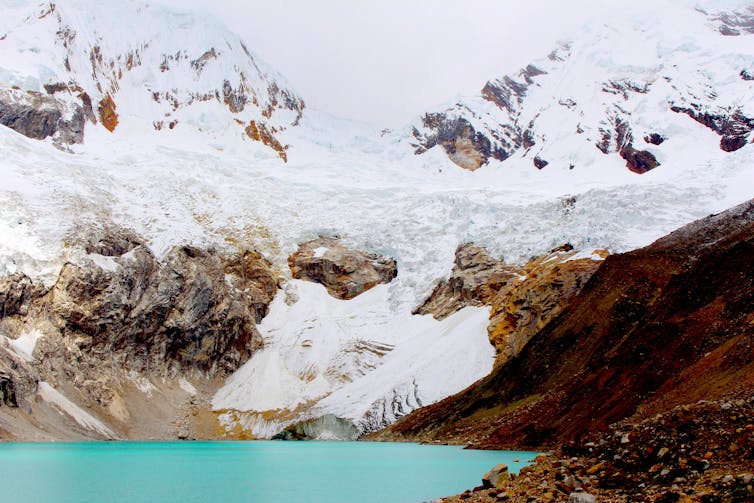
Walking along the lake’s edge, a distant crash broke the silence. “It’s just a small avalanche – that happens all the time,” explained one of the villagers working for the local government who are present here around the clock to watch over the lake. Far away on the glacier, I spotted a flurry of falling snow. “You see? This one didn’t even reach the lake.” I wondered about the consequences of a bigger avalanche on the residents of the valley below, including the Luciano Lliuya family.
Back down in the village over our guinea pig lunch, Julio (who was in his seventies) explained he had transferred his property in the flood danger zone to his seven children. To our surprise, the youngest of them, Saúl, offered to make the claim against RWE.
“All right then,” said Christoph Bals, Germanwatch’s policy director. “We’re going to court!”
An outlandish idea
When I began working on this project nearly a decade ago, holding a major emitter responsible for climate change occurring across the world seemed an outlandish idea. German lawyers had come up with the idea of bringing a claim under the country’s neighbourhood law (part of the extensive German Civil Code) – but this idea had yet to be tested in court.
When Saúl Luciano Lliuya first heard about this option, he said his preferred option was to confront a major polluter, so we settled on a claim against the German multinational RWE. Based some 6,500 miles away in the industrial city of Essen, RWE has produced coal-fired energy since it was founded in the 19th century. Much more recently, its plans for the huge new Garzweiler open-cast coalmine in western Germany have been met with sustained protests and some controversy about RWE’s relationship with the regional police.
Read more: German police have long collaborated with energy giant RWE to enforce ecological catastrophe
Over the past 25 years, the energy company has diversified into renewable energy, and states that it will be “climate neutral by 2040”. A 2014 study, commissioned by the Climate Justice Programme in Australia, estimated that RWE had produced 0.47% of all the world’s industrial greenhouse gas emissions between 1854 and 2010.
In Luciano Lliuya’s homeland, the local government plans to build a new dam and drainage system at Lake Palcacocha to reduce the risk of flooding, at a projected cost of about US$4 million. Luciano Lliuya, via the lawsuit, wants RWE to cover 0.47% of that sum, or around US$20,000.
The case’s central argument is simple: that climate change makes everyone in the world potential neighbours – so, RWE should be a good neighbour and accept its responsibility for contributing to climate change impacts in Peru.
Initially, a lower court in Essen ruled (in December 2016) that the lawsuit against the energy giant was unfounded. However, the following November, this was overruled by the Higher Regional Court in Hamm, which declared the case admissible and began examining the evidence.
The requested sum of US$20,000 is a symbolic amount of money, of course – RWE’s legal costs are likely to go much higher. Yet, when the judges suggested an out-of-court settlement at a hearing in 2017, the company’s lawyer refused, stating: “This is a matter of precedent.”
The estimated cost of future climate-related claims extends into the billions.
The legal strategy
“This feels like we’re at 5,000 metres in the Andes,” remarks Saúl Luciano Lliuya as, fighting a biting wind, we walk to the Essen courthouse. It is November 2015 and this is his first trip outside Peru – accompanied by his father. Acting as guide and interpreter, I freeze alongside them in my thick winter coat while these two hardy Peruvians sport only light jackets.
A TV crew is filming as Luciano Lliuya enters the courthouse with his lawyer to submit the claim against RWE. They emerge a few minutes later, and he gives a statement to the awaiting journalists and TV cameras:
I’m making this claim because the mountains in Peru are suffering. The glaciers are melting. We haven’t caused this problem – it’s big companies like RWE. Now they must take responsibility.
Speaking to the press is a new and nerve-wracking experience for him. But when he thinks about the mountains and why he is taking this action, a fire seems to light up inside.

Later that day, after we escape the cameras, I ask what his neighbours back in Peru think about the lawsuit. His only aim, after all, is to benefit his community in the face of dramatic changes to their Andean environment. He seeks no personal gain; only that RWE covers part of the costs of a public infrastructure project to reduce the risk of flooding from Lake Palcacocha.
“I don’t know what [my fellow villagers] think,” Luciano Lliuya replies. “I haven’t told anyone.” Acknowledging my surprise, he says he isn’t sure how to explain it to them:
They live with climate change in their own way, but they don’t all have the scientific facts. I’m afraid that some people might not understand how me going to Germany helps us in Peru.
It turns out that his fear is well-founded. When his neighbours find out about his legal claim – whether from news reports, social media or word of mouth – some are confused by it. Rumours begin to spread: that he is making lots of money from the claim, or selling the lake to the Germans. Upon his return home, he explains to his neighbours that nobody is paying him to make the claim, and that success would ultimately help them all. Still, many remain suspicious.
The irony that this case, revolving around neighbourhood law, risks upsetting his own neighbours in Peru is not lost on Luciano Lliuya. The lawsuit applies nuisance law, which is typically applied in neighbourhood disputes, to climate change impacts.
Imagine this: your neighbour has a wall that borders on your property. The wall is old and crumbling, and you’re afraid it could fall over and damage your house. If that happens, you can sue your neighbour for damages. But you’d rather not wait – you don’t want to live with the uncertainty. So instead, you sue your neighbour using the nuisance law. If you win, the court will order them to fix the wall – or in Luciano Lliuya’s case, get rid of the flood hazard.
Around the world, others have attempted similar lawsuits before, to no avail. In 2008, for example, the Native Alaskan community of Kivalina filed a claim against ExxonMobil and other oil majors in the US. Their village is threatened by rising sea levels, so the complainants demanded support for adaptation costs – but that case was dismissed on the grounds that climate change is a political issue that should not be resolved in the courts.
Since then, political progress has proved largely inadequate in mobilising support for those who are most vulnerable to climate change. At the same time, climate science has evolved rapidly, drawing ever more precise links between major emitters and impacts around the world.
Since 2017, around 40 US states and cities have filed lawsuits against the fossil fuel industry, arguing that companies such as ExxonMobil knew about the dangers of climate change decades ago but hid this knowledge from consumers. The plaintiffs have included cities such as New York and San Francisco that are threatened by sea level rise and have demanded billions of dollars to cover their adaptation costs. Their actions have received support from US president Joe Biden’s administration, and earlier in 2023, the Supreme Court ruled the cases should be heard in state rather than federal courts. Many legal analysts believe these cases have a better chance of success in state courts, and they are likely to go to trial soon.

After Dutch NGO Milieudefensie filed a lawsuit against the oil and gas multinational Shell, in 2021 a Dutch court ordered that the company should reduce its emissions by 45% by 2030. (There are, though, enforcement challenges with multinational corporations, and since the verdict Shell has moved its corporate headquarters from the Netherlands to the UK.) Lawsuits in numerous countries have forced governments to increase climate action. But, almost eight years after he delivered the complaint to the snowy Essen courthouse in November 2015, Luciano Lliuya’s case has made it furthest of all.
Most fossil fuel companies are no longer engaging in climate denial. RWE acknowledges the dangers of global warming and claims to be “at the leading edge of the shift to sustainable energy.” Yet the company is still making massive profits with fossil fuels, and refuses to pay up for damage caused by past emissions.
A battle over the science
I know of no other case where attribution science is so important. This is a real battle of science. (Roda Verheyen, Luciano Lliuya’s lead lawyer)
In early 2021, Luciano Lliuya’s legal team submitted a new piece of impartial evidence: a scientific study linking flood risk in the Peruvian Andes to global warming. It found that around 95% of the glacier’s retreat at Lake Palcacocha is due to human-made climate change. One media article called it a “smoking gun”.
After RWE’s lawyers challenged the legal validity of the study, in July 2021 the court acknowledged it as a piece of independently produced evidence, meaning it is “of higher value than private expert opinions commissioned by the parties”.
In response, RWE’s legal team presented a study in the scientific journal Remote Sensing, which analysed satellite data for the glacier above Lake Palcacocha and found there was “no evidence of significant glacial instability” within a three-year observation period. RWE’s lawyers used this study to argue that a large avalanche is unlikely – a position that has been strongly contested by Luciano Lliuya’s legal team.
RWE states that as well as modernising its coal-fired power plants to reduce CO₂ emissions, it has invested billions in renewable energy, reflecting Germany’s policy to phase out fossil fuels. Within an article about the case on the climate investigations website SourceMaterial, RWE spokesperson Guido Steffen commented:
Individual emitters are not liable for universally rooted and globally effective processes like climate change. It is judicially impossible to relate specific or individual consequences of climate change to a single person.

‘This close to winning’
In the years since I first met Luciano Lliuya in 2014, as well as working with him as a legal adviser and strategist, I’ve also completed a PhD on how climate change affects people in the Peruvian Andes, linking their concerns with legal and political discussions across the world. But the case is still far from over: legal proceedings move slowly, and the next hearing is due to be held in the first half of 2024.
But the case has already inspired other claims: in July 2022, Indonesian islanders threatened by sea-level rise filed a similar lawsuit against the Swiss cement producer Holcim. A recent case in Italy asks for a declaration of responsibility for climate damage from ENI, an Italian oil company. And in September 2023, the European Court of Human Rights heard a legal action posed by Portuguese young people aged 11-24 against 33 European governments over what they claim is a failure to adequately tackle global heating.
Meanwhile, the plight of Luciano Lliuya’s community has been covered by media outlets across the planet. When his lawsuit began, it felt to all involved that victory was nearly impossible – we might get past a few legal hurdles, then move on to the next case. Almost a decade on, we never imagined we’d get this far, and be this close to winning the case.
Back in Luciano Lliuya’s village, the criticism of his motives has slowly subsided. “A big step was when the court came to visit us [in 2022],” Luciano Lliuya explains. “People saw that this is something serious. It wasn’t just me.”
Community leaders joined the court’s inspection at Lake Palcacocha and shook the judges’ hands. At the same time, Luciano Lliuya has helped establish a local NGO that supports farmers in adapting to climate change through sustainable agriculture. The organisation is called Wayintsik – Quechua for “our house”.
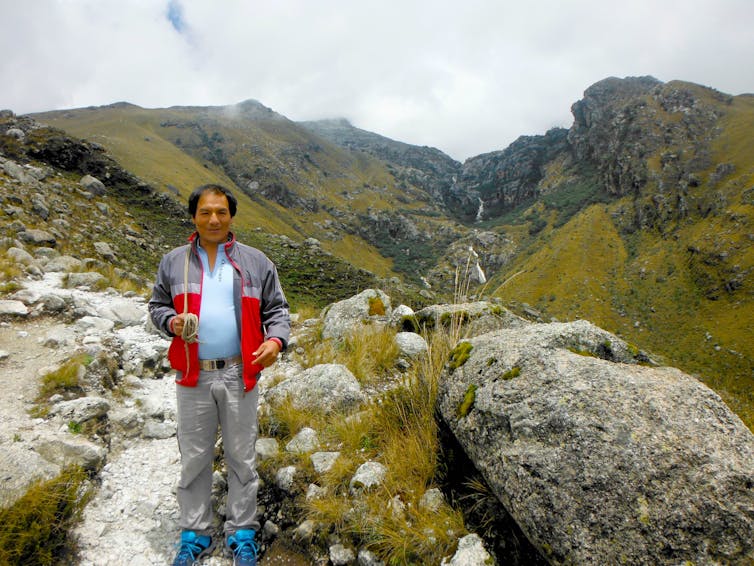
While the legal process moves slowly on, they have no choice but to adapt – and not just to the threat posed by the lake. Weather patterns are becoming less reliable. The Peruvian Andes usually have a dry season from May to August, and farmers rely on the first rains in September to plant their crops. Now, the rains sometimes begin too early, or not until November. New pests are also harming their potato harvests – the warming climate has brought rats to higher altitudes, for example.
In the long term, climate change could have even more devastating impacts on Luciano Lliuya’s community. Glaciers are natural water storage devices so, as they disappear, the people here will face water scarcity. “If there’s no more water,” he says, “we’ll lose our livelihoods. There will be nothing left.” No water for the fields, no glaciers to climb.
But Luciano Lliuya is stubborn. In the face of malicious rumours and unwanted attention, others might have given up. He just climbed more mountains.
After attending COP27 in Sharm El-Sheikh in November 2022, he went on an all-night trek which included climbing Mount Sinai, following in the steps of Moses. The sandy landscape was a sharp contrast to the glaciers and green pastures he is used to in Peru. Squinting into the rising sun, he reflected on the perils of life on a warming planet.
He said it made him imagine a bleak future in which the whole world resembles these surroundings: “That’s why I’ll continue fighting – so that our mountains back home don’t turn to desert too one day.”

For you: more from our Insights series:
To hear about new Insights articles, join the hundreds of thousands of people who value The Conversation’s evidence-based news. Subscribe to our newsletter.

